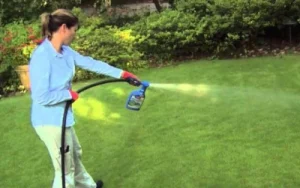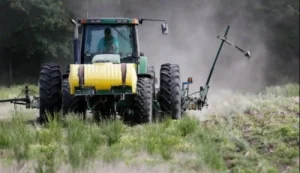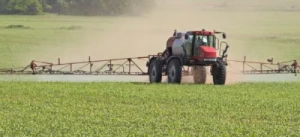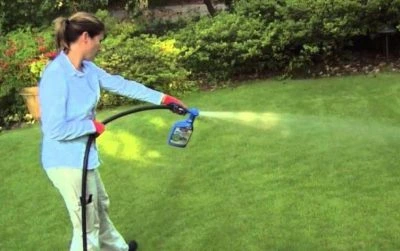No products in the cart.
Field
The Best Time Of Day To Spray Weed Killers: PLUS 3 More Factors
There are many reasons that make weed control ineffective. Factors such as the time of day you are spraying, the weather, the season, and the temperature can all affect herbicide efficacy and should all be taken into account.
Below is all the information on the best time to spray weed killers, including the best time of the year, the best time of the day, the best weather, and the best temperature for an effective herbicide application.
But generally, the ideal time is early in the morning when the winds are not blowing.
*This post may have affiliate links, which means I may receive commissions if you choose to purchase through links I provide (at no extra cost to you). As an Amazon Associate I earn from qualifying purchases. Please read my disclaimer for additional details.
Best Time Of Year To Spray Weeds

Early Spring
In early spring, pre-emergent spraying is an effective way to prevent unwanted weeds before they start.
This will also help control the germination of seeds. If the weed has already sprouted and is visible, pre-emergent spraying will be useless.
After 8 weeks, it will be time to apply post-emergent spraying to destroy the hardier weeds.
Remember, however, that it is more successful and beneficial to kill young and immature weeds.
Fall
During Fall, weeds are in storage mode and preparing for winter and will be vulnerable at this time.
At this time, it is best to spray them with a post-emergent herbicide to give them little chance of surviving in the cold weather.
If you see that the weeds are not wilting immediately, do not panic. It takes time to kill them. Be confident that a majority of them will not come back in the upcoming springtime.
The best month to do this is October and you can spray weed killer 2 times 2 weeks apart.
Late Summer
You can also spray weed killer in late summer before the weeds knock down their seeds.
If the seeds land on the ground, new weed generation will grow, thus this spraying time can prevent them from spreading.
Also, it is important to identify the type of weed you are trying to kill as choosing the wrong herbicides will only waste your time and money.
Best Time Of Day To Spray Weeds

Just like the time of year, time of day can affect the effectiveness of spraying.
The best time of day to spray weed killers is during peak plant growth times during the day.
Over the day, plants can grow fast or slow depending on light level, temperature, and local climate.
1. Warm Climates
In summer, during the early morning and late afternoon when it is warm and not too hot is the most suitable time for weeds to grow fast and is thus, the best time to spray.
You should not spray around the middle or early afternoon, or the hottest part of the day.
During the hottest part of the day, plants will grow more slowly, and therefore will absorb less herbicide.
Also, the sun and hot temperatures will dry out the herbicide on the leaves, therefore reducing the amount absorbed.
In winter, you can still spray if you want as the weeds often continue to grow. But during winter, the best time is the middle of the day when it is warmer.
2. Cool Or Cold Climates
In summer, unlike the warm climates, the spraying should be done in the late morning, middle, and early afternoon.
From dusk to the following morning before sunrise, plants are less active.
Also, do not apply herbicide if you see dew on the leaves.
If you spray weed killer with dew on the leaves, the spray will run off or it will become too diluted and reduce effectiveness.
So, it is better to wait until the dew has evaporated.
In winter, weeds are often covered by snow or ice so it is good to tread weeds.
In the fall, you can spray weeds during the warmest part of the day.
Read More: Best Trimmer Lines for TOUGH Landscapes. We tested the top weed eater lines to see how they would stand up to the toughest home and commercial conditions. Here’s what we found.
Best Weather To Spray Weeds

Weather is also a factor that contributes to the effectiveness of the spraying. So it is important to know how to treat your weeds in different types of weather.
1. Wind
Unless you want the spray to drift off the target, it should not be too windy. Usually, wind speeds greater than 15 km/h (9.3mph) can cause a loss of herbicide during spraying.
Drift is something you really need to avoid as you are more likely to inhale the herbicide fumes when spraying.
This can cause damage to your respiratory system. Moreover, drift is sometimes illegal.
Usually, in the morning and evening, the wind is calmer.
The following are things to consider in windy conditions, but no current method can eliminate drift completely:
- Read the herbicide label. It may indicate the maximum wind speed to be allowed.
- Use methods to reduce drift, such as: using drift-mitigating nozzles, larger droplets, low nozzle height, slower forward speed, etc.
- Do not spray if the wind blows faster than the speed you are spraying. You may contact the drift when spraying when the wind is behind you.
- If there is a temperature inversion, drift can also be a problem in light winds.
- Know the wind direction where the spray will drift as this can be an advantage in high wind.
- Sometimes, it is worth spraying in strong wind. For example, if you intend to spray a selective herbicide in wheat and down-wind there is another wheat field, spraying will be probably safe in strong wind.
2. Rain
Rainfall shortly after spraying can wash all the chemicals off your plants before it has worked, and a waste of money.
What is worse, the chemicals may end up in a local river, polluting the environment.
Allow at least 24 hours to let the rain dry. If raindrops are still on the leaves, you will need to wait longer. If you plan to spray, remember to check the weather forecast to choose a suitable day.
If your area often receives a great deal of rain, there are certain weed killers which can work fast in 2 to 4 hours of spraying. So make sure you take your local weather into consideration when purchasing herbicides.
3. Extreme Heat Or Cold
If it is too hot or cold, the herbicide will not be effective and the weeds will not absorb the chemicals as usual.
If it is too hot, the herbicide liquid can evaporate too quickly before it is absorbed. Meanwhile, if it is too cold, it will freeze.
Best Temperature To Spray Weed Killers
Herbicides usually have the best performance when the temperature is from 60 to 75ºF. This temperature range should not fluctuate for a few hours afterward.
If the temperature is under 60ºF, weeds will grow slowly leading to slower chemical absorption and translocation. This means the onset of symptoms and herbicide efficacy will be slower.
If the temperature is under 40ºF, avoid spraying systemic herbicides such as glyphosate. Moreover, under cloudy conditions (and also below 40ºF), weed control should not be applied.
If a severe frost is forecasted after an intended weed-killer application, you also should not spray. If weeds are under stress, the efficacy of herbicide will drop.
If you are unsure about if it is the right time, it is best to wait for better weather conditions to come.
However, for some conditions that your plans need treatment immediately, be careful in choosing herbicides that are the best killer for the targeted weed.
FAQs
1. Is it better to pull weeds or spray them?
If you are trying to remove large weed infestations, spraying weeds is better.
However, if you are looking to remove just a handful of weeds, hand-weeding is preferable. Keep in mind that weeds re-grow easily if you rely on hand-pulling.
2. Should you water after weed killer?
You should wait at least 24 hours before watering after applying weed killer to ensure the spray dries fully and does not become diluted.
3. What kills weeds permanently?
Applying and reapplying herbicides can kill weeds permanently over time.
It is also said that vinegar can be used and can be more effective against immature dandelions and crabgrass.
4. Should I cut weeds before spraying?
It is not advised to cut weeds before spraying as herbicides only work if they are applied to leaves and stems.
Cutting weeds beforehand will remove the easiest route for the herbicide to take.
Likewise, it is recommended to wait at least 5 days to mow after applying weed killer.
5. Does adding dish soap to Roundup help?
You can add 1 Tbsp of dish soap per 1 gallon of the liquid herbicide as dish soap can be used as a surfactant but it should not be relied on.
6. Do you need to wear a mask when spraying Roundup?
When spraying Roundup, it is highly recommended to wear a face mask or a respirator, especially when heavy misting is present.
In general, it is also advised to wear a face mask or respirator when using any weed killer due to the chemicals in the herbicide that can be harmful to humans.
Conclusion
Sometimes, killing weeds is just like a chore with no end. They are noxious and so frustrating to destroy.
Knowing what factors contribute to the effectiveness of your chosen herbicide effectiveness is ultimately the best plan for success.
We hope this guide will allow you to enjoy your garden and field throughout the year.

